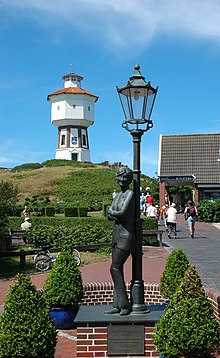Langeoog
Langeoog (Low German: Langeoog) is one of the seven inhabited East Frisian Islands at the edge of the Lower Saxon Wadden Sea in the southern North Sea, located between Baltrum Island (west), and Spiekeroog (east).
Langeoog's actual size depends on the level of tide, which rises and falls about 2.5 metres (8 ft 2.4 in) in 6 hours.
Every island except Juist and Langeoog has large concrete groynes at its western end to reduce erosion.
During the Nazi era, the government expanded Langeoog as an air base starting in 1940.
On August 22, 1940, 250 French prisoners of war were transferred to the island to perform forced labor.
They died due to inhumane treatment; a memorial at the Langeoog Dunes Cemetery today commemorates their fate.
The island's unpolluted air makes it popular with people who have respiratory problems.
Singer-songwriter Lale Andersen, whose 1939 interpretation of the song Lili Marleen became tremendously popular during World War II, lived here for several years.




